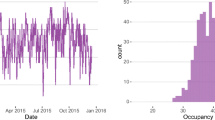Abstract
Despite the considerable number of publications on ICU patient flow and analysis of its variability, a basic and practically important question remained unanswered: what maximum number of elective surgeries per day should be scheduled (along with the competing demand from emergency surgeries) in order to reduce diversion in an ICU with fixed bed capacity to an acceptable low level, or prevent it at all? The goal of this work was to develop a methodology to answer this question. An ICU patient flow simulation model was developed to establish a quantitative link between the daily load leveling of elective surgeries (elective schedule smoothing) and ICU diversion. It was demonstrated that by scheduling not more than four elective surgeries per day ICU diversion due to ‘no ICU beds’ would be practically eliminated. However this would require bumping ‘extra’ daily surgeries to the block time day of another week which could be up to 2 months apart. Because not all patients could wait that long for their elective surgery, another more practical scenario was tested that would also result in a very low ICU diversion: bumping ‘extra’ daily elective surgeries within less than 2 weeks apart, scheduling not more than five elective surgeries per day, and strict adherence to the ICU admission/discharge criteria.












Similar content being viewed by others
References
Litvak, E., Long, M., Cooper, A., and McManus, M., Emergency department diversion: Causes and solutions. Acad. Emerg. Med. 8:111108–1110, 2001.
Haraden, C., Nolan, T., and Litvak, E., Optimizing patient flow: Moving patients smoothly through acute care setting. Institute for Healthcare Improvement Innovation Series 2003. White Papers 2: Cambridge, MA, 2003.
Litvak, E., and Long, M., Cost and quality under managed care: Irreconcilable differences? Am. J Manag Care. 6:3305–312, 2000.
Going Lean in Health Care. Institute for Healthcare Improvement (IHI), Innovative Series, White Papers, 2005. Editor: Miller, D. www.ihi.org
Zidel, T., A Lean guide to transforming healthcare. Milwaukee, WI: American Society for Quality Press, 2006.
McManus, M., Long, M., Cooper, A., and Litvak, E., Queuing theory accurately models the need for critical care resources. Anesthesiology. 100:51271–1276, 2004.
McManus, M., Long, M., Cooper, A., Mandell, J., Berwick, D., Pagano, M., and Litvak, E., Variability in surgical caseload and access to intensive care services. Anesthesiology. 98:61491–1496, 2003.
Gallivan, S., Utley, M., Treasure, T., and Valencia, O., Booked inpatient admissions and hospital capacity: Mathematical modeling study. Br. Med. J. 324:280–282, 2002, (Feb 2).
Buhaug, H., Long waiting lists in hospitals. Br. Med. J. 324:252–253, 2002, (Feb 2).
Harrison, G., Shafer, A., and Mackay, M., Modeling variability in hospital bed occupancy. Health Care Manage. Sci. 8:325–334, 2005.
Glantz, S., Primer of biostatistics. (6th ed.), New York: McGraw-Hill, 2005.
Green, L., Soares, J., Giglio, J., and Green, R., Using queuing theory to increase the effectiveness of emergency department provider staffing. Acad. Emerg. Med. 13:61–68, 2006.
Green, L., Kolesar, P., and Svoronos, A., Some effects of non-stationarity on multi-server Markovian queuing systems. Oper. Res. 39:502–511, 1991.
Green, L., Kolesar, P., and Soares, J., Improving the SIPP approach for staffing service systems that have cyclic demands. Oper. Res. 49:549–564, 2001.
Hall, R., Queuing methods for service and manufacturing. Prentice Hall, New York, 1990.
Lowery, J., Design of hospital admissions scheduling system using simulation. Proceedings of the 1996 Winter Simulation Conference. Charness, J., Morrice, D. (Eds.), pp. 1199–1204, 1996.
Lowery, J., Introduction in simulation in healthcare. Proceedings of the 1996 Winter Simulation Conference. Charness, J., Morrice, D. (Eds.), pp. 78–84, 1996
Kim, S., Horowitz, I., Young, K., and Buckley, T., Flexible bed allocation and performance in ICU. J. Oper. Manag. 18:427–433, 2000.
Kim, S., Horowitz, I., Young, K., and Buckley, T., Analysis of capacity management of the ICU in hospital. Eur. J. Oper. Res. 115:36–46, 1999.
Duckworth, W., Operational research techniques. Methuen, London, 1962.
Adan, I., and Vissers, J., Patient mix optimization in hospital admission planning: A case study. Int. J. Oper. Prod. Manag. 22:445–461, 2002.
Dexter, F., Macario, A., Traub, R., Hopwood, M., and Lubarsky, D., An operating room scheduling strategy to maximize the use of operating room block time: Computer simulation of patient scheduling and survey of patients' preferences for surgical waiting time. Anesth. Analg. 89:7–20, 1999.
Dexter, F., Macario, A., O, and Neill, L., Scheduling surgical cases into overflow block time—Computer simulation of the effects of scheduling strategies on operating room labor costs. Anesth. Analg. 90:4980–988, 2000.
Dexter, F., and Traub, R., How to schedule elective surgical cases into specific operating rooms to maximize the efficiency of use of operating room time. Anesth. Analg. 94:4933–942, 2002.
Tyler, D. C., Pasquariello, C. A., and Chen, C.-H., Determining optimum operating room utilization. Anesth. Analg. 96:41114–1121, 2003.
Van Houdenhoven, M., van Oostrum, J. M., Hans, E. W., Wullink, G., and Kazemier, G., Improving operating room efficiency by applying bin-packing and portfolio techniques to surgical case scheduling. Anesth. Analg. 105:3707–714, 2007.
Mazzei, W., Maximizing operating room utilization: A landmark study. Anesth. Analg. 89:1–2, 1999.
Kolker, A., Process modeling of emergency department patient flow: Effect of patient length of stay on ED diversion. J. Med. Syst., 2008 (in press, DOI 10.1007s10916-008-9144-x).
Author information
Authors and Affiliations
Corresponding author
Rights and permissions
About this article
Cite this article
Kolker, A. Process Modeling of ICU Patient Flow: Effect of Daily Load Leveling of Elective Surgeries on ICU Diversion. J Med Syst 33, 27–40 (2009). https://doi.org/10.1007/s10916-008-9161-9
Received:
Accepted:
Published:
Issue Date:
DOI: https://doi.org/10.1007/s10916-008-9161-9




